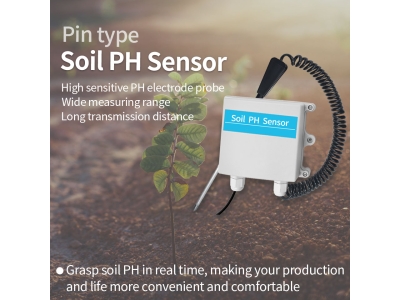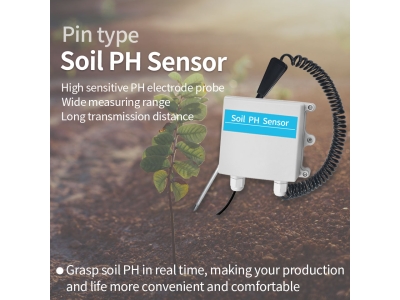Agriculture is undergoing a revolutionary transformation, thanks to the integration of cutting-edge technologies. One such technology with immense potential is soil sensor technology. By providing real-time data on soil properties, soil sensors enable farmers to make informed decisions, optimize resource usage, and enhance crop productivity. This article explores the concept of smart agriculture, the role of soil sensor technology, its applications in farming, and the future prospects it holds.
Smart Agriculture and Its Benefits:
Smart agriculture, also known as precision agriculture or digital farming, involves the use of technology to optimize agricultural practices. It encompasses the integration of various technologies like Internet of Things (IoT), artificial intelligence (AI), data analytics, and remote sensing. The primary goal of smart agriculture is to increase productivity, reduce resource wastage, minimize environmental impact, and improve sustainability. Soil sensor technology plays a vital role in achieving these objectives by providing accurate and timely information about soil conditions.

Understanding Soil Sensor Technology:
Soil sensors are devices designed to measure and monitor different parameters related to soil health. These sensors employ various techniques to collect data, including electrical resistivity, capacitance, and spectral analysis. Some common parameters measured by soil sensors include moisture content, temperature, pH levels, electrical conductivity, nutrient availability, and compaction. The collected data is then transmitted to a central system for analysis and interpretation.
Applications of Soil Sensor Technology in Farming:
3.1 Irrigation Management:
Water scarcity is a significant challenge in agriculture, making efficient irrigation crucial. Soil sensors provide real-time data on soil moisture levels, allowing farmers to optimize irrigation scheduling. By knowing the exact water needs of the crops, farmers can ensure that the plants receive adequate water without overirrigating. This precision irrigation not only conserves water but also prevents waterlogging, reduces energy consumption, and promotes healthier plant growth.
3.2 Nutrient Management:
Proper nutrient management is vital for optimum crop growth and yield. Soil sensors help farmers understand the nutritional status of the soil by measuring nutrient levels and pH. This data enables farmers to apply fertilizers precisely, based on the specific needs of the crops and the soil's nutrient content. By avoiding over-fertilization or under-fertilization, farmers can minimize nutrient runoff, reduce environmental pollution, and enhance nutrient use efficiency.
3.3 Disease and Pest Management:
Soil sensors can play a role in early disease and pest detection. Certain soil conditions, such as excessive moisture or pH imbalances, can create favorable environments for pathogens and pests. By continuously monitoring these parameters, farmers can detect potential disease outbreaks or pest infestations and take timely action to mitigate their impact. This proactive approach reduces the reliance on broad-spectrum pesticides and promotes sustainable pest management practices.
3.4 Soil Health Monitoring and Conservation:
Soil health is fundamental to the long-term sustainability of agriculture. Soil sensors provide valuable insights into soil properties like compaction, organic matter content, and salinity levels. Farmers can use this information to assess soil health, identify areas that require remediation, and implement appropriate measures accordingly. By addressing soil health issues promptly, farmers can prevent yield losses, maintain soil fertility, and promote sustainable farming practices.
Advancements and Integration with Other Technologies:
Soil sensor technology continues to evolve rapidly, driven by advancements in IoT, AI, and automation. Miniaturized sensors with wireless connectivity have made soil monitoring more accessible and scalable. Additionally, the integration of soil sensors with other technologies enhances their capabilities. For example, combining soil moisture data with weather forecasts enables automated irrigation systems to adjust watering schedules based on predicted rainfall. Similarly, integrating soil sensor data with crop growth models and satellite imagery allows for precise fertilizer recommendations and targeted interventions.
Future Prospects and Challenges:
The future of smart agriculture with soil sensor technology is promising, but challenges remain. One significant challenge is the standardization of sensor data and interpretation methods across different soil types and regions. Calibration protocols and data analysis algorithms need to be developed to ensure accuracy and consistency. Additionally, cost-effectiveness and user-friendliness are crucial factors for the wider adoption of soil sensors by farmers.
Conclusion:
Smart agriculture, powered by soil sensor technology, promises to revolutionize farming practices. By providing real-time and accurate data on soil conditions, soil sensors enable farmers to make informed decisions, optimize resource usage, and improve crop productivity. The integration of soil sensors with other technologies further enhances their capabilities and opens new horizons for sustainable agriculture. With continued advancements and collaborative efforts, smart agriculture with soil sensor technology holds the key to a more efficient, productive, and sustainable future in farming.






